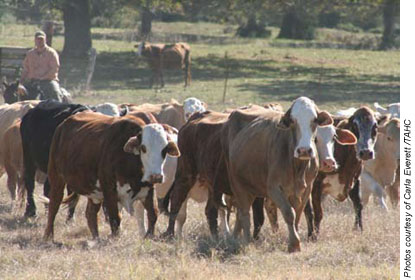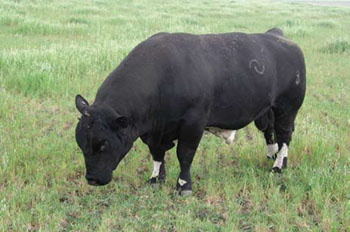Texas joins states with bovine trichomoniasis regulations
The nation's largest cattle-producing state is the latest to adopt regulations to try to control the spread of a bovine disease that reduces calf crops.
Starting April 1, the regulations adopted by the Texas Animal Health Commission require bovine trichomoniasis testing for nonvirgin bulls prior to importation into the state. TAHC commissioners approved the regulations Feb. 24.

Bovine trichomoniasis is associated with abortions, extended calving sessions, metritis, and infertility, but a vaccine can reduce the duration of infection in cows. There is no effective approved treatment for bulls.
Dr. Bob Hillman, executive director of the TAHC, said laboratory reports have shown trichomoniasis is spread across the state. Those reports are the result of efforts made by veterinarians after herd owners asked for help in identifying the source of problems, but the reports are not able to provide complete prevalence and distribution data.
"It does, however, give us significant information that the disease is prevalent in most areas, if not all areas, in the state of Texas," Dr. Hillman said.
The disease is costly for producers, and it can put them out of business if they don't act to control the problem, Dr. Hillman said. He read a report in early January indicating that one producer lost a third of his calf crop in each of the two years after trichomoniasis was introduced into his herd, and that producer's report was not unusual.
Dr. John Wenzel, a mixed animal practitioner and an extension veterinarian for New Mexico State University, said trichomoniasis is a highly transmissible problem.
"In the premises that I deal with where we've had trich, I would say it runs from a 15 to 30 percent loss of pregnancy," Dr. Wenzel said.
In the rangelands of New Mexico, ranchers typically pay between $2,000 and $4,000 for bulls, Dr. Wenzel said. Ranchers often have one bull for every 15 or 20 cows, and they lose substantial investments whenever bulls only a few years old test positive for trichomoniasis.
"When a bull breeds a positive cow, 95 percent of them will develop the infection, with most of those becoming chronically infected," Dr. Wenzel said. "Because there's no [approved] treatment, the only thing you can do is slaughter the bull."
The regulations in Texas will implement a control program that affects breeding bulls, whereas some other states' rules affect all cattle. The program is not designed to eliminate the disease; elimination is extremely difficult because of chronic, subclinical infections, especially in older bulls.
"It's designed to gain control and to provide some assurance to producers that the bulls they're buying are not going to bring the disease into their herd," Dr. Hillman said. "They're still going to have to deal with cows—purchasing cows—and ensure as best they can they're not infected."
Dr. Hillman also noted the difficulty of trying to eliminate the disease without help from all states.
"How do we eliminate it without the whole country being a part of that process?" Dr. Hillman said.
Under Texas' newly adopted regulations:
- Beginning April 1, breeding bulls older than 24 months or not certified as virgins will need negative test results for trichomoniasis within 30 days before entering Texas for breeding purposes.
- Trichomoniasis test results in Texas will be reported to the TAHC within 48 hours, regardless of test outcome.
- Bulls that test positive for trichomoniasis may undergo a confirmatory test. Infected bulls would be taken to slaughter directly or through a livestock market.
- Beginning Jan. 1, 2010, nonvirgin bulls changing possession within Texas will need to be tested prior to transfer to new owners.
- Beginning in 2010, bulls without certification as virgins or negative trichomoniasis tests that are changing possession will be allowed only to be sold for slaughter or moved under hold order and movement permit to a site specified by the TAHC. At that site, they will be isolated from female cattle and undergo testing.
Disease spread varies by state
At least 15 other states in the western U.S. have similar trichomoniasis-related programs, Dr. Hillman said.
A surge in bovine trichomoniasis reports led South Dakota state authorities to implement testing requirements for cattle sales starting in June 2005.
Sam Holland, South Dakota state veterinarian, said his office occasionally saw trichomoniasis reports before 2004, and it had been on the state's list of reportable diseases for years. The policy during that time was to meet with owners and discuss with them how to manage the disease without regulatory action.
South Dakota had 45 reported cases from July 1, 2004, to June 30, 2005, and Dr. Holland said the spike in reports was likely related to an increase in feeder calf prices—particularly heifers—which led people to sell heifer calves and buy older, nonvirgin replacements. States south and west of South Dakota also have cattle infected with trichomoniasis, and that may have been related to the increase, he said.
The disease decreased the number of calves born at production facilities with infections, and Dr. Holland said the number of cases could have doubled the next year if no action were taken.
Awareness by producers and marketers, cooperation from auction markets, and the control program itself helped keep the problem from worsening, Dr. Holland said. About 30 cases were reported between mid-2005 and January 2009.
Unlike the regulations in Texas, South Dakota's regulations restrict nonvirgin and nonpregnant cows from being imported, loaned, leased, or acquired for breeding purposes in the state.
Dr. Hillman recognizes that cows are a major factor in perpetuating the disease and that the state can gain control of trichomoniasis' spread by regulating the sale of bulls and providing an educational component regarding cows.
Dr. Peter Vanderloo, associate director of the Wisconsin Veterinary Diagnostic Laboratory, University of Wisconsin-Madison, said artificial insemination is widely used by producers in his state, where trichomoniasis is not a major disease concern. The diagnostic laboratory performs thousands of trichomoniasis tests yearly without identifying pathogenic trichomonads.
 Restricting movement of nonvirgin cattle is extremely important in reducing the disease's spread, Dr. Wenzel said. About three percent of bulls tested are positive for trichomoniasis, down from about six percent in 2006, he said.
Restricting movement of nonvirgin cattle is extremely important in reducing the disease's spread, Dr. Wenzel said. About three percent of bulls tested are positive for trichomoniasis, down from about six percent in 2006, he said.
North-central, northeast, and southwest New Mexico are all inundated with bovine trichomoniasis, Dr. Wenzel said. His practice is in the southwestern part of the state.
New Mexico authorities made trichomoniasis a reportable disease after an increase in prevalence in the north-central part of the state in spring 2005, Dr. Wenzel said. Like other states, New Mexico began requiring testing of certain bulls.
Dr. Wenzel has dealt with trichomoniasis on large ranches, and aggressive reaction to the disease has helped bring business back to normal on those ranches.
"I think it's important to jump at the very beginning and do everything you can because, in my clients, it's returned them to a more normal situation much faster than the folks who want to drag their feet," Dr. Wenzel said.
He said ranchers need to think of trichomoniasis as a regional disease rather than a particular ranch's problem.
"If a ranch spends the money and cleans up the disease and the surrounding neighbors have trich, the disease will probably reappear via stray cattle," Dr. Wenzel said. "Ranchers need to band together and have an area or regional approach to controlling trich. They need to contact their local veterinarian for control strategies."